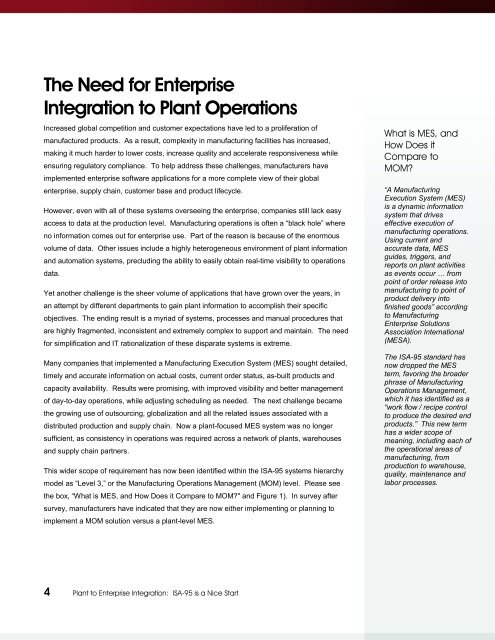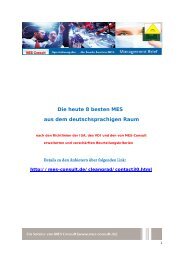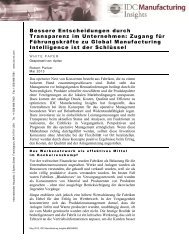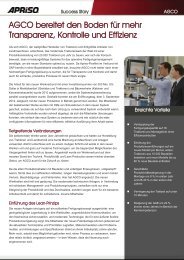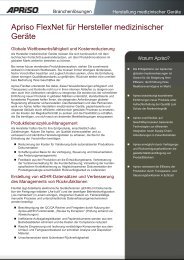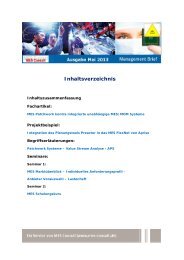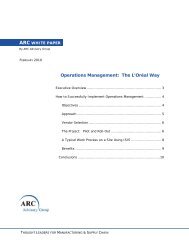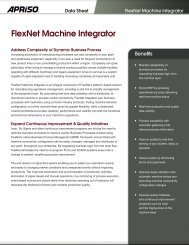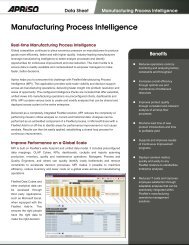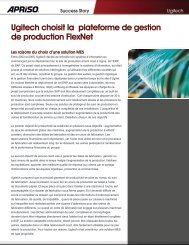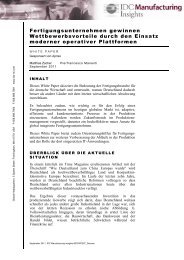ISA-95 is a Nice Start - Apriso
ISA-95 is a Nice Start - Apriso
ISA-95 is a Nice Start - Apriso
You also want an ePaper? Increase the reach of your titles
YUMPU automatically turns print PDFs into web optimized ePapers that Google loves.
The Need for Enterpr<strong>is</strong>e<br />
Integration to Plant Operations<br />
Increased global competition and customer expectations have led to a proliferation of<br />
manufactured products. As a result, complexity in manufacturing facilities has increased,<br />
making it much harder to lower costs, increase quality and accelerate responsiveness while<br />
ensuring regulatory compliance. To help address these challenges, manufacturers have<br />
implemented enterpr<strong>is</strong>e software applications for a more complete view of their global<br />
enterpr<strong>is</strong>e, supply chain, customer base and product lifecycle.<br />
However, even with all of these systems overseeing the enterpr<strong>is</strong>e, companies still lack easy<br />
access to data at the production level. Manufacturing operations <strong>is</strong> often a “black hole” where<br />
no information comes out for enterpr<strong>is</strong>e use. Part of the reason <strong>is</strong> because of the enormous<br />
volume of data. Other <strong>is</strong>sues include a highly heterogeneous environment of plant information<br />
and automation systems, precluding the ability to easily obtain real-time v<strong>is</strong>ibility to operations<br />
data.<br />
Yet another challenge <strong>is</strong> the sheer volume of applications that have grown over the years, in<br />
an attempt by different departments to gain plant information to accompl<strong>is</strong>h their specific<br />
objectives. The ending result <strong>is</strong> a myriad of systems, processes and manual procedures that<br />
are highly fragmented, incons<strong>is</strong>tent and extremely complex to support and maintain. The need<br />
for simplification and IT rationalization of these d<strong>is</strong>parate systems <strong>is</strong> extreme.<br />
Many companies that implemented a Manufacturing Execution System (MES) sought detailed,<br />
timely and accurate information on actual costs, current order status, as-built products and<br />
capacity availability. Results were prom<strong>is</strong>ing, with improved v<strong>is</strong>ibility and better management<br />
of day-to-day operations, while adjusting scheduling as needed. The next challenge became<br />
the growing use of outsourcing, globalization and all the related <strong>is</strong>sues associated with a<br />
d<strong>is</strong>tributed production and supply chain. Now a plant-focused MES system was no longer<br />
sufficient, as cons<strong>is</strong>tency in operations was required across a network of plants, warehouses<br />
and supply chain partners.<br />
Th<strong>is</strong> wider scope of requirement has now been identified within the <strong>ISA</strong>-<strong>95</strong> systems hierarchy<br />
model as “Level 3,” or the Manufacturing Operations Management (MOM) level. Please see<br />
the box, “What <strong>is</strong> MES, and How Does it Compare to MOM?" and Figure 1). In survey after<br />
survey, manufacturers have indicated that they are now either implementing or planning to<br />
implement a MOM solution versus a plant-level MES.<br />
4 Plant to Enterpr<strong>is</strong>e Integration: <strong>ISA</strong>-<strong>95</strong> <strong>is</strong> a <strong>Nice</strong> <strong>Start</strong><br />
What <strong>is</strong> MES, and<br />
How Does it<br />
Compare to<br />
MOM?<br />
“A Manufacturing<br />
Execution System (MES)<br />
<strong>is</strong> a dynamic information<br />
system that drives<br />
effective execution of<br />
manufacturing operations.<br />
Using current and<br />
accurate data, MES<br />
guides, triggers, and<br />
reports on plant activities<br />
as events occur … from<br />
point of order release into<br />
manufacturing to point of<br />
product delivery into<br />
fin<strong>is</strong>hed goods” according<br />
to Manufacturing<br />
Enterpr<strong>is</strong>e Solutions<br />
Association International<br />
(MESA).<br />
The <strong>ISA</strong>-<strong>95</strong> standard has<br />
now dropped the MES<br />
term, favoring the broader<br />
phrase of Manufacturing<br />
Operations Management,<br />
which it has identified as a<br />
“work flow / recipe control<br />
to produce the desired end<br />
products.” Th<strong>is</strong> new term<br />
has a wider scope of<br />
meaning, including each of<br />
the operational areas of<br />
manufacturing, from<br />
production to warehouse,<br />
quality, maintenance and<br />
labor processes.


